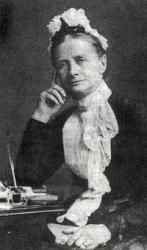Scripture References:
st. 1 = Matt. 6:28-29
all st. = Gen 1:31, Eccles. 3:11, Neh. 9:6, Ps. 148
Cecil F. Alexander (PHH 346) wrote a number of hymn texts on articles of the Apostles' Creed. This text, whose biblical source is Genesis 1:31 ("and God saw all that he had made, and it was very good"), is Alexander's explanation of the Creed's phrase "Maker of heaven and earth." The text was first published in her Hymns for Little Children (1848) in seven stanzas, one of which was:
The rich man in his castle,
The poor man at his gate,
God made them high and lowly
And ordered their estate.
In the currently familiar form of this hymn Alexander's original first stanza has been turned into the refrain, and her stanzas 3 and 6 have been omitted.
The vivid images depicting the creedal statement are easily understood by God's children of all ages. It is a catalog text (see also 431 and 433) because it enumerates various creatures God has made: flowers and birds (st. 1); mountains, rivers, daylight, and evening (st. 2); summer, winter, and harvest (st. 4). The final stanza and the refrain teach us that the creation points to and praises the Creator, for "the Lord God made them all." Note that "all" is used four times in the refrain!
Liturgical Use:
As a creation hymn, especially for children but also suitable for adults; with Heidelberg Catechism, Lord's Day 9, as a hymn of confession of faith.
--Psalter Hymnal Handbook
==========================
All things bright and beautiful. Cecil F. Alexander, née Humphreys. [God, our Maker.] A successful and popular hymn for children, on the article of the Creed, "Maker of Heaven and Earth," which appeared in her Hymns for Little Children, 1848, in 7 stanzas of 4 lines. It is usually given in an unaltered form, as in Thring's Collection, 1882.
-- John Julian, Dictionary of Hymnology (1907)
Hymnary Pro Subscribers
Access
an additional article
on the Canterbury Dictionary of Hymnology:
Hymnary Pro subscribers have full access to the Canterbury Dictionary of Hymnology.
Get Hymnary Pro


 My Starred Hymns
My Starred Hymns








